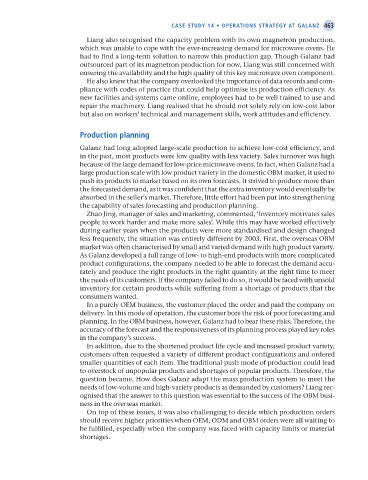Page 488 - Operations Strategy
P. 488
case study 14 • OperatiOns strategy at galanz 463
Liang also recognised the capacity problem with its own magnetron production,
which was unable to cope with the ever-increasing demand for microwave ovens. He
had to find a long-term solution to narrow this production gap. Though Galanz had
outsourced part of its magnetron production for now, Liang was still concerned with
ensuring the availability and the high quality of this key microwave oven component.
He also knew that the company overlooked the importance of data records and com-
pliance with codes of practice that could help optimise its production efficiency. As
new facilities and systems came online, employees had to be well trained to use and
repair the machinery. Liang realised that he should not solely rely on low-cost labor
but also on workers’ technical and management skills, work attitudes and efficiency.
production planning
Galanz had long adopted large-scale production to achieve low-cost efficiency, and
in the past, most products were low quality with less variety. Sales turnover was high
because of the large demand for low-price microwave ovens. In fact, when Galanz had a
large production scale with low product variety in the domestic OBM market, it used to
push its products to market based on its own forecasts. It strived to produce more than
the forecasted demand, as it was confident that the extra inventory would eventually be
absorbed in the seller’s market. Therefore, little effort had been put into strengthening
the capability of sales forecasting and production planning.
Zhao Jing, manager of sales and marketing, commented, ‘Inventory motivates sales
people to work harder and make more sales’. While this may have worked effectively
during earlier years when the products were more standardised and design changed
less frequently, the situation was entirely different by 2003. First, the overseas OBM
market was often characterised by small and varied demand with high product variety.
As Galanz developed a full range of low- to high-end products with more complicated
product configurations, the company needed to be able to forecast the demand accu-
rately and produce the right products in the right quantity at the right time to meet
the needs of its customers. If the company failed to do so, it would be faced with unsold
inventory for certain products while suffering from a shortage of products that the
consumers wanted.
In a purely OEM business, the customer placed the order and paid the company on
delivery. In this mode of operation, the customer bore the risk of poor forecasting and
planning. In the OBM business, however, Galanz had to bear these risks. Therefore, the
accuracy of the forecast and the responsiveness of its planning process played key roles
in the company’s success.
In addition, due to the shortened product life cycle and increased product variety,
customers often requested a variety of different product configurations and ordered
smaller quantities of each item. The traditional push mode of production could lead
to overstock of unpopular products and shortages of popular products. Therefore, the
question became, How does Galanz adapt the mass production system to meet the
needs of low-volume and high-variety products as demanded by customers? Liang rec-
ognised that the answer to this question was essential to the success of the OBM busi-
ness in the overseas market.
On top of these issues, it was also challenging to decide which production orders
should receive higher priorities when OEM, ODM and OBM orders were all waiting to
be fulfilled, especially when the company was faced with capacity limits or material
shortages.
Z14 Operations Strategy 62492.indd 463 02/03/2017 13:59

